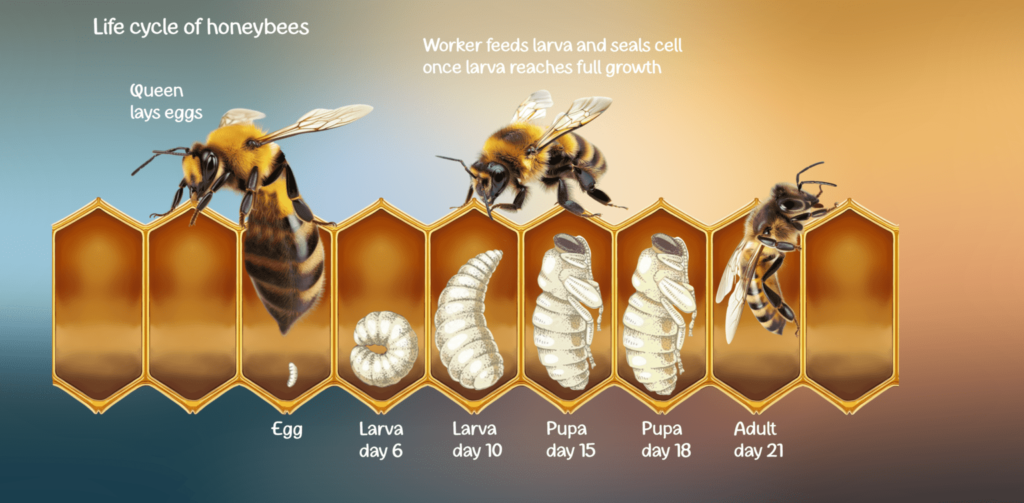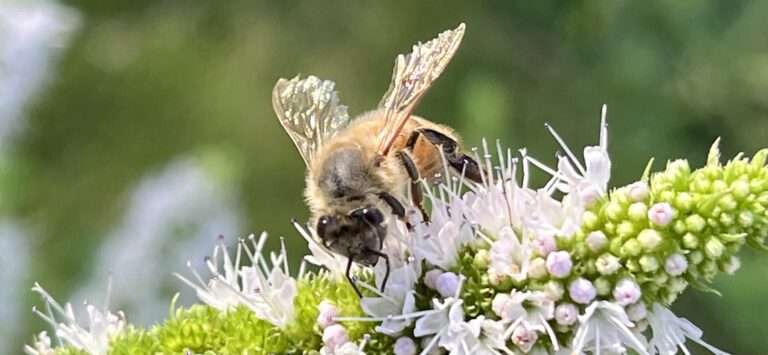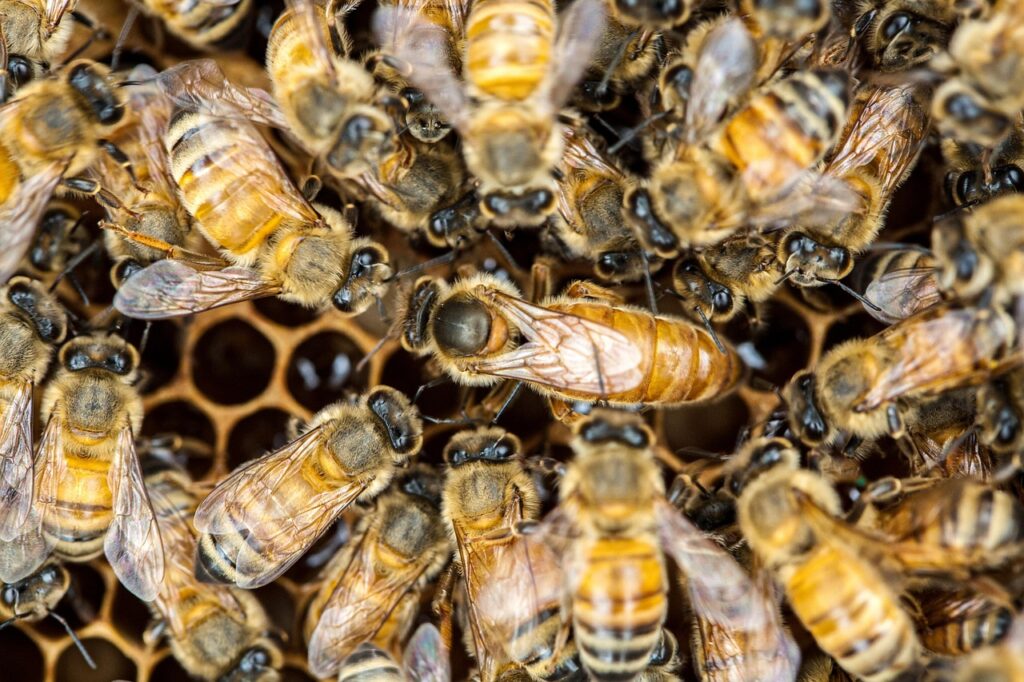A Basic Overview of the Life Cycle of the Honey Bee
Honey bees undergo complete metamorphosis, a remarkable transformation process where they progress through four distinct developmental stages: egg, larva, pupa, and adult[1][2].
This process is also called holometabolous development, meaning the larval stage looks completely different from the adult form[3][4].

Honey bee life cycle showing the four stages of complete metamorphosis
The Four Stages of Development
Stage 1: Egg (3 Days)
The honey bee life cycle begins when the queen bee lays a single egg in each hexagonal wax cell[1][5].
These tiny, white eggs are approximately 1 mm long and resemble small grains of rice[6][7]. When first laid, the egg stands upright on the bottom of the cell, but gradually tilts over during its three-day development period[5].
All honey bee eggs, regardless of their future caste (queen, worker, or drone), remain in this stage for exactly].
Stage 2: Larva (5-6 Days)
After three days, the egg hatches into a larva – a white, grub-like creature without eyes, legs, wings, or antennae[1][6].
The larvae are curled in a characteristic “C” shape at the bottom of their cells[5][8]. During this crucial stage, nurse bees feed the larvae continuously.
Feeding determines destiny: All larvae initially receive royal jelly for the first three days of larval life[9][10]. However, after this period:
- Future queens continue receiving royal jelly exclusively throughout their development[11][12]
- Workers and drones are switched to a mixture of honey and pollen called “bee bread”[9][13]
The larval stage lasts approximately 5.5 days for queens, 6 days for workers, and 6.5 days for drones[14][13].
Stage 3: Pupa (7-14 Days)
When the larvae are ready to transform, worker bees cap their cells with a thin layer of wax[1][5]. Inside this sealed environment, the larva spins a cocoon around itself and enters the pupal stage[1][15].
This is when the most dramatic changes occur – the transformation from a grub-like larva into an adult bee with recognizable body parts.
During the pupal stage, the bee develops:
- Compound eyes (which are the first features to develop color)
- Wings and legs
- Head, thorax, and abdomen
- Body hair and other adult characteristics[5][15]
The pupal stage duration varies by caste:
Stage 4: Adult Emergence
Once fully developed, the adult bee chews through the wax capping of its cell and emerges to join the colony[1][6]. The total development time from egg to adult varies:
Adult Life Spans
After emerging, honey bees have dramatically different lifespans depending on their role:
- Queen bees can live 2-5 years, with some exceptional cases reaching up to 8 years[17][18][19]
- Worker bees typically live 5-7 weeks during active seasons (spring/summer) but can live up to 20 weeks during winter[18][20]
- Drone bees live approximately 8 weeks, though they die shortly after mating or are expelled from the hive before winter[17][18]
The Role of Nutrition in Development
The honey bee life cycle demonstrates one of nature’s most remarkable examples of how nutrition can completely alter an organism’s developmental path[21][22].
Despite having nearly identical genetics, queens and workers develop into vastly different forms based solely on their larval diet.
Royal jelly contains special proteins and nutrients that trigger the genetic expression necessary for queen development, including fully developed ovaries and enlarged body size[12][23].
This complete metamorphosis allows honey bees to maximize their survival strategy – larvae are specialized for growth and feeding, while adults are equipped for their various roles in maintaining the complex social structure of the hive[3][4].
⁂
- https://hbrc.ca/stages-of-bee-growth/
- https://www.buzzaboutbees.net/beelifecycle.html
- https://beeculture.com/a-closer-look-32/
- https://www.sare.org/publications/managing-alternative-pollinators/chapter-three-a-brief-natural-history-of-bees/development-and-reproduction-of-bees/
- https://canr.udel.edu/maarec/honey-bee-biology/the-colony-and-its-organization/
- https://www.orkin.com/pests/stinging-pests/bees/honey-bees/life-cycle-of-a-honey-bee
- https://www.studocu.com/en-ca/messages/question/8449868/how-many-days-does-a-honey-bee-normally-remain-in-the-egg-stage-after-being-laid
- https://sites.google.com/view/livmee/the-metamorphosis-of-the-bee
- https://www.youtube.com/watch?v=sCtC8oGEhyk
- https://beeculture.com/royal-jelly-worker-bee-produced-protein-rich-mothers-milk/
- https://www.eurekaselect.com/chapter/18469
- https://en.wikipedia.org/wiki/Royal_jelly
- https://projects.sare.org/media/pdf/T/h/e/The-life-cycle-of-honey-bees.pdf
- https://theholyhabibee.com/bees-life-cycle/
- https://www.ck12.org/flexi/life-science/agriculture/what-is-the-life-cycle-of-honeybees/
- https://en.wikipedia.org/wiki/Honey_bee_life_cycle
- https://www.orkin.com/pests/stinging-pests/bees/honey-bees/honey-bee-life-cycle
- https://www.orkin.com/pests/stinging-pests/bees/honey-bees/honey-bee-life-span
- https://a-z-animals.com/blog/honey-bee-lifespan-how-long-do-honey-bees-live/
- https://royalsocietypublishing.org/doi/10.1098/rsos.200998
- https://pmc.ncbi.nlm.nih.gov/articles/PMC6169885/
- https://beeculture.com/a-closer-look-47/
- https://phys.org/news/2011-09-queen-bee-worker-insights-famous.html



